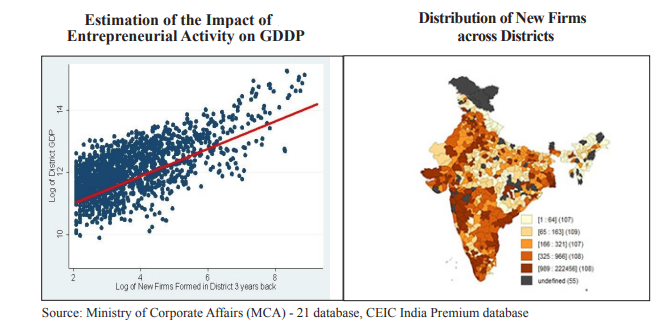According to a press release issued by the Ministry of Finance, the Indian economy is expected to grow by 9.2% in real terms in 2021-22 (based on preliminary estimates), after contracting by 7.3% in 2020-21. GDP is expected to increase by 8-8.5% in real terms in 2022-23.
According to the International Monetary Fund’s most recent World Economic Outlook, India’s real GDP will grow at a rate of 9% in 2021-22 and 2022-23, and 7.1% in 2023-2024, making it the world’s fastest growing major economy in all three years.

The Bloomberg chart on stock market performance lists four of India’s stock indexes among the top 10 best performing indexes in Asia. India has been doing well despite all odds related to the pandemic. This has helped drive up the country’s market capitalization-to-GDP ratio. This ratio is expected to reach an all-time peak of 188% this fiscal year.

The focus of the Union Budget 2022 on economic growth is consistent with Modi’s vision of making India Atmanirbhar: a digital superpower, a sustainability leader, and a healthy nation. I have already shared my view on it here bit.ly/3wKZfCb. This statement of intent is clearly supported by a future plan, as well as allocations to support Indian ambitions in infrastructure, digital transition, planet resilience, education, and health.
India is emerging as a hub for start-ups due to high growth rates and factors such as developing markets, increased political will and government support, technological innovations, changing perceptions of entrepreneurship, and so on. Many entrepreneurs prefer to invest in information technology, finance, software, and other fields in order to make more money. The number is expected to rise in the future due to the availability of skilled labour and government policies.

When efficiency is enhanced, it impacts wealth creation of the country and forms an integral part of the process. A key dimension of efficiency pertains to opportunity. Equal opportunity for new entrants is important. According to a survey of : CMIE, Company Annual reports and Survey calculations, a 10 % increase in new firms in a district yields, 1.8 % increase in Gross Domestic District Product (GDDP).
The effect of new firm creation on district-level GDP demonstrates that grassroots entrepreneurship is motivated by more than just necessity. Indeed, indicates that, while the peninsular states dominate new firm entry, entrepreneurship is spread across India and is not limited to a few metropolitan cities.
As per the 2020 wealth report by Karvy, individual wealth in India rose 9.56% to Rs. 465 lakh crores. India is fifth in terms of the number of HNI (high net-worth individuals) and U-HNI (ultra-high net worth individuals) in the world. The HNI population in the country has risen by 2.73% to reach 263,000. A HurunGlobal Rich List 2020 Survey shows that India creates three US dollar billionaires every month!
These numbers indicate that we are seeing India growing exponentially and being a digital superpower. When our country is making such leaps in wealth creation, it is important to understand how the diversification of this wealth has taken place across the nation.
Wealth in financial assets constitutes 56.52% as per Karvy Wealth Report. Cash, Savings Accounts, Insurance, Fixed Deposits, and Direct Equity are the most preferred investment channels. Gold, silver and real estate emerged as sure winners in the physical asset class.
Continuing with the current trends, by FY25, the individual wealth in India will showcase a healthy CAGR of 11.77%. The valuation is expected to reach Rs. 811 lakh crores with Rs 512 lakh crores at a CAGR of 14.27% in financial assets. As India becomes wealthier, the allocation of financial assets will increase to 63.13%, thereby showing a clear trend of moving away from physical assets.
This shift in financial assets is due to the rapidly transforming wealth management sector. Technology has accelerated the scope of wealth creation in India by ushering in a ‘WealthTech’ era which is driving the growth of alternate digital investments like crypto. The adoption of crypto skyrocketed to unprecedented levels. Between April 2020 and May 2021, investments rose by a whopping 400 per cent, increasing from USD 923 million to nearly USD six billion.
According to a new research, India currently has the highest number of cryptocurrency owners globally, at 10.07 crore. 40 % of the investors aged 18 to 40, 47% of the Gen Z and 39% of the millennial respondents own cryptocurrencies. This trend has prompted the RBI to propose the introduction of Digital Rupee using blockchain and other technologies, which is likely to debut by early 2023.
The country’s enormous tech talent and thriving entrepreneurial culture is a potential pool for digital innovation. The use of Blockchain, Big Data and other related technologies is revolutionizing this. Digital assets are enhancing wealth creation and financial inclusion by helping the people in remote villages or without bank accounts to gain access to financial services and credit more easily. All this has led to an increase in economic activity of the nation.
As clearly seen above there is a dynamic shift in wealth creation in India. The emerging affluent class includes today’s genZ and millennials, who are open to experimenting and dabbling in various asset classes. They would be strongly inclined towards digital first interfaces and solutions. The time is ripe for independent wealth managers to redefine their strategy and operations for servicing this segment.
I encourage wealth managers to leverage the latest technology and tools like artificial intelligence, big data and machine learning. The real challenge lies in providing investors with smart, professional, and personalized financial services. It is an opportunity for advisors to combine the very best of technological and human capital and make a mark in a booming economy.